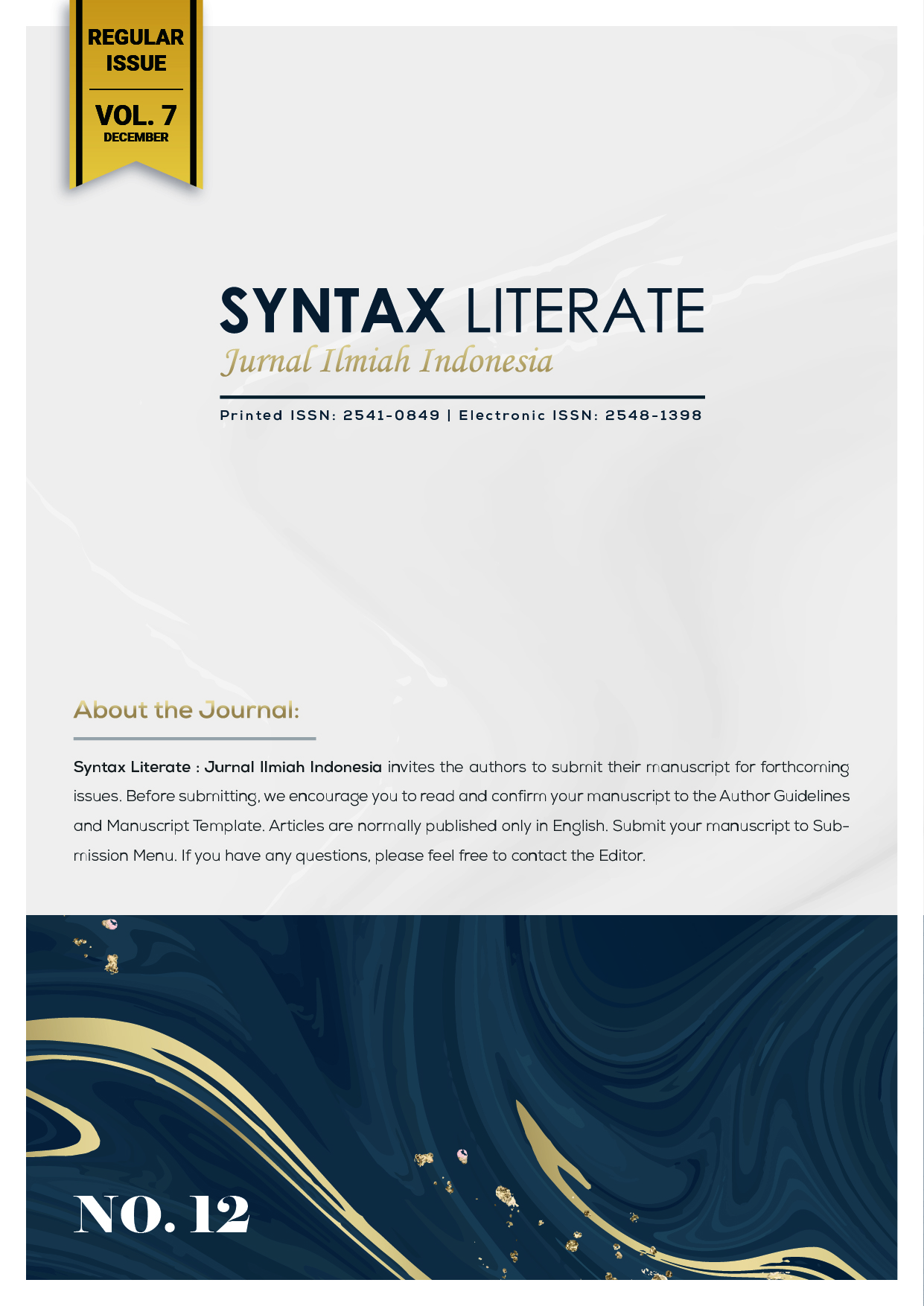Analisis Kelayakan Learning Management System (LMS) Learnpress bagi Pembelajaran Daring pada Startup Berbasis Pendidikan
Abstract
Sebagai ujung tombak pendidikan guru diharapkan untuk mampu melaksanakan proses pembelajaran yang sesuai dengan kebutuhan siswa. Selain melakukan tugas utama mengajar, guru juga mengerjakan tugas atau kegiatan lain dalam lingkungan sekolah. Dalam upaya meningkatkan teacher performance banyak faktor yang mempengaruhinya, diantaranya adalah teacher emotional labor, teacher work engagement dan teacher commitment. Penelitian ini bertujuan untuk mengetahui pengaruh teacher emotional labor, teacher work engagement, dan teacher commitment terhadap teacher performance. Subjek penelitian adalah 71 guru yang mengajar di sekolah SMP Strada Cabang JPBS. Desain penelitian ini adalah analisis jalur dengan pendekatan kuantitatif. Hasil penelitian ini menunjukkan bahwa teacher emotional labor mempengaruhi teacher performance secara positif, teacher work engagement mempengaruhi teacher performance secara positif, dan teacher commitment mempengaruhi teacher performance secara positif pula. Ditunjukkan pula bahwa teacher commitment memediasi pengaruh positif teacher emotional labor terhadap teacher performance. Teacher commitment memediasi pengaruh positif teacher work engagement terhadap teacher performance.
Downloads
References
Cahyani, A., Listiana, I. D., & Larasati, S. P. D. (2020). Motivasi Belajar Siswa SMA pada Pembelajaran Daring di Masa Pandemi Covid-19. IQ (Ilmu Al-Qur’an): Jurnal Pendidikan Islam, 3(01), 123–140. https://doi.org/10.37542/iq.v3i01.57
Ellis, R. K. (2009). A Field Guide to Learning Management Systems (Learning Circuits). the American Society for training & Development (ASTD).
Ginting, E. (2013). Aplikasi Penjualan Berbasis Web (E-COMMERCE) Menggunakan JOOMLA pada Mutiara Fashion.
Handini, D., Hidayat, F., Naser Rafi’i attamimi, A., Alif Vatul Putri, D., Fasha Rouf, M., & Raly Anjani, N. (2020). Statistik Pendidikan tinggi 2020 (F. Hardiyanto & D. A. Akbar, Eds.; Vol. 5). Sekretaris Direktorat Jendral Pendidikan Tinggi.
Jesukiewicz, P. (2004). Sharable Content Object Reference Model (R) 2004 4th Edition Content Aggregation Model Version 1.0. ADLNet.gov
Koopmans, C., & Mouter, N. (2020). Cost-benefit analysis. In Advances in Transport Policy and Planning (Vol. 6, pp. 1–42). Elsevier B.V. https://doi.org/10.1016/bs.atpp.2020.07.005
Kordaki, M., & Daradoumis, T. (2009). Critical Thinking as a Framework for Structuring Synchronous and Asynchronous Communication within Learning Design-Based E-Learning Systems.
Liang, Y., Dai, K., & Matthews, K. E. (2020). Students as Partners: A New Ethos for the Transformation of Teacher and Student Identities in Chinese Higher Education. In International Journal of Chinese Education (Vol. 9, Issue 2, pp. 131–150). Brill Academic Publishers. https://doi.org/10.1163/22125868-12340124
Mukhtar, K., Javed, K., Arooj, M., & Sethi, A. (2020). Advantages, Limitations and Recommendations for Online Learning During Covid-19 Pandemic Era. Pakistan Journal of Medical Sciences, 36(COVID19-S4), S27–S31. https://doi.org/10.12669/pjms.36.COVID19-S4.2785
Murphy, E., RodrÃguez-Manzanares, M. A., & Barbour, M. (2011). Asynchronous and Synchronous Online Teaching: Perspectives of Canadian High School Distance Education Teachers. In British Journal of Educational Technology (Vol. 42, Issue 4, pp. 583–591). https://doi.org/10.1111/j.1467-8535.2010.01112.x
PBB. (2019). Review of SDG Implementation and Interrelations Among Goals Discussion on SDG 4-Quality Education. sustainabldevelopment.un.org/hlpf/2019 Picciano, A. G. (2002). Beyond Student Perceptions: Issues of Interction, Presence, and
Performance in an Online Course. In JALN (Vol. 6, Issue 1).
Ravoof, S. (2016, June 16). The Ideal WordPress PHP and Server Requirements. https://kinsta.com/blog/wordpress-server-requirements/
Satzinger, J. W., Jackson, R. B., & Burd, S. D. (2010). System Analysis and Design in aChanging World. www.cengage.com/highered
Sekhon, H., Ennew, C., Kharouf, H., & Devlin, J. (2014). Trustworthiness and Trust: Influences and Implications. Journal of Marketing Management, 30(3–4), 409–430. https://doi.org/10.1080/0267257X.2013.842609
Stefan Hratinski. (2008). Asynchronous & Synchronous E-Learning (4th ed., Vol. 4) Educause Quarterly.
Sterne, J. (2019). Plug-in. In Encyclopedia Britanica. Ecyclopedia Britannica. Supratman, Arianto, T., & Maiyana, E. (2020). Development of Local Web-Based
Learning (LWBL) as Low-Cost Digital Learning Efforts. Journal of Physics: Conference Series, 1471(1), 2. https://doi.org/10.1088/1742-6596/1471/1/012003
Tata Sutabri. (2012). Konsep Sistem Informasi (Inunk Nastiti, Ed.). CV ANDI OFFSET. Whitten Professor Lonnie D Bentley Professor, J. L., Burr Ridge, B., Dubuque, I., &
Madison, lA. (2007). System Analysis and Design Methods.
Wild, S., & Heuling, L. S. (2020). Student Dropout and Retention: An Event History Analysis Among Students in Cooperative Higher Education. International Journal of Educational Research, 104, 101687.
Xu, P., & Yue, X. (2019). Talent Leadership Strategies Enhance Teacher’s Professional Competencies in 21st Century Education for Sustainable Development. IOP Conference Series: Earth and Environmental Science, 373(1). https://doi.org/10.1088/1755-1315/373/1/012003
Yakub. (2012). Pengantar Sistem Informasi (1st ed., Vol. 1). GRAHA ILMU.
Copyright (c) 2022 Narendra Bagus Adiyaksa

This work is licensed under a Creative Commons Attribution-ShareAlike 4.0 International License.











